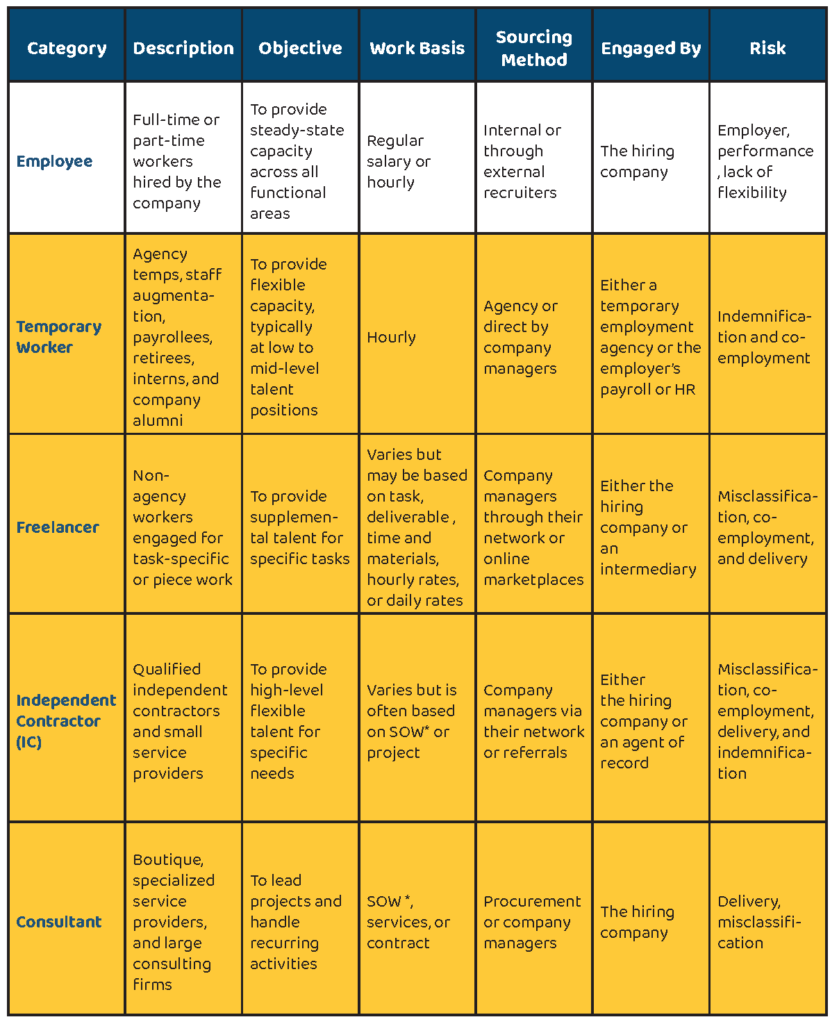Discover how contingent talent helps businesses gain flexibility, access specialised skills, and optimise costs
Economic uncertainty, technological advances, and changing worker preferences have reshaped how organisations operate and engage with talent. At the center of this transformation is the contingent worker – a professional who provides services to an organisation on a non-permanent basis.
Unlike traditional employees, contingent workers don’t have fixed, long-term employment relationships with a single organisation. Instead, they offer specialised skills and services for specific projects, time periods, or objectives. This arrangement provides organisations with greater workforce flexibility while giving professionals more control over their careers.
Understanding the strategic advantages of contingent workers and how to manage them effectively can give your organisation a significant competitive edge in accessing specialised talent and controlling workforce costs.
Types of Contingent Workers
The contingent workforce encompasses several distinct categories of professionals, each with unique characteristics and advantages:
Total Talent Continuum

*Statement of Work
Key Benefits of Contingent Workers
Contingent workers deliver specific business value that traditional employment models can’t match:
Workforce Flexibility and Scalability
Contingent workers enable organisations to adjust their workforce size quickly in response to changing business needs, seasonal demands, or economic fluctuations. According to Staffing Industry Analysts’ Workforce Solutions Buyer Survey 2024, workforce flexibility consistently ranks as the top benefit cited by organisations using contingent talent.
Access to Specialised Skills
Many contingent workers are specialised professionals with expertise that may not exist within an organisation’s permanent workforce. This allows businesses to access niche skills for specific projects without the long-term commitment of a full-time hire.
Cost Efficiency
Engaging contingent workers can convert fixed labor costs to variable expenses. Organisations can avoid the overhead associated with full-time employees, including benefits, office space, equipment, and training costs.
Reduced Time-to-Market
With their specialised expertise, contingent workers can often deliver results more quickly than permanent employees who might require extensive training for specialised projects. This accelerates implementation timelines for critical initiatives.
Fresh Perspectives and Innovation
Contingent workers bring diverse experiences from their work with multiple organisations. This external perspective can spark innovation and introduce new approaches to solving business challenges.
Common Implementation Challenges
While the benefits are compelling, organisations should be aware of several challenges when engaging contingent workers:
Classification and Compliance
Properly classifying workers as employees or independent contractors is crucial, as misclassification can lead to significant legal and financial penalties. Regulations vary by jurisdiction and are constantly evolving.
Administrative Complexity
Managing contingent workers involves unique processes for onboarding, time tracking, payments, and offboarding that differ from traditional employment models.
Global Variations
For organisations operating internationally, navigating different labor laws, tax requirements, and cultural expectations adds another layer of complexity to contingent workforce management.
How People2.0 Simplifies Contingent Workforce Management
As organisations navigate these challenges, a specialised partner can provide invaluable support. People2.0 offers comprehensive solutions through our employer of record (EOR) and agent of record (AOR) services:
- Global Compliance Expertise: We navigate complex worker classification and employment regulations across jurisdictions.
- Streamlined Administration: Our solutions handle contracts, onboarding, payments, and offboarding processes.
- Risk Mitigation: As your EOR or AOR partner, we assume employment-related compliance risks.
- Enhanced Worker Experience: Our efficient systems ensure contingent workers have a positive engagement experience.
Taking the Next Step: Your Contingent Workforce Strategy
Building an effective contingent workforce strategy requires thoughtful planning and implementation. To help organisations navigate this process, we’ve developed a comprehensive resource: 9 Steps to Building a Successful Contingent Workforce Strategy.
In this detailed guide, you’ll discover:
- A proven framework for developing your contingent workforce strategy
- Best practices for workforce classification and compliance
- Strategic approaches to sourcing and engaging contingent talent
- Practical methods for integrating contingent workers with your permanent workforce
- Risk mitigation strategies for global contingent workforce programs
Ready to optimise your approach to contingent workforce management? Download our eBook today to learn how your organisation can access the right talent, at the right time, in the right way.



